PETALING JAYA, Aug 31 — In line with the spirit of this year’s Hari Merdeka theme Sayangi Malaysiaku, let's revisit how the Bunga Raya became a symbol of love for the birth of our nation.
In 1958, a year after Malayans shouted “Merdeka!” for the first time, the Ministry of Agriculture invited proposals for a national flower from all state governments.
Seven flowers were proposed, including hibiscus (Bunga Raya), ylang ylang (bunga kenanga), jasmine (bunga melur), magnolia (bunga cempaka), lotus (bunga teratai), rose (bunga mawar) and medlar (bunga tanjung).
The rose was preferred by those living on the East Coast, while those in the West Coast were partial to the jasmine.
After careful consideration, then Prime Minister Tunku Abdul Rahman Putra Al-Haj declared the hibiscus, or more specifically its subspecies Hibiscus rosa-sinesis, as the national flower on July 28, 1960.
The vibrant colours of the flower made it stand out; it also symbolised the courage and vitality of the people
The five conspicuous petals of the flower also fit well with the five principles of the Rukun Negara.
Apart from those reasons, the flower was commonly seen all over the country, blooming all day long and decorating the fences of many households.
While the hibiscus syracus is South Korea’s national flower and the yellow hibiscus is Hawaii’s state flower, hibiscus rosa-sinesis was chosen for the newly-independent Malaya.
Named Bunga Raya, with raya meaning celebratory or grand, the flower literally means “celebratory flower”, to reflect the celebration of unity in a multicultural nation.
More than just a national symbol, the flower can be made into a tea that is said to help reduce high blood pressure. The flower is commonly used to treat hair loss by Ayurveda physicians in India, and its roots are used as an aperitif and tonic.



















